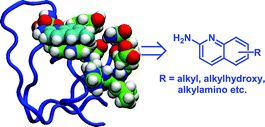Synthesis of 5-, 6- and 7-substituted-2-aminoquinolines as SH3 domain ligands
Abstract
The Src homology 3 (SH3) domains are small

* Corresponding authors
a
Discipline of Chemistry, School of Chemistry and Physics, The University of Adelaide, Adelaide, SA, Australia
E-mail:
simon.pyke@adelaide.edu.au
Fax: +61 8 8303 4358
Tel: +61 8 8303 5358
b Discipline of Biochemistry, School of Molecular and Biomedical Science, The University of Adelaide, Adelaide, SA, Australia
The Src homology 3 (SH3) domains are small

 Please wait while we load your content...
Something went wrong. Try again?
Please wait while we load your content...
Something went wrong. Try again?
S. Inglis, R. Jones, D. Fritz, C. Stojkoski, G. Booker and S. Pyke, Org. Biomol. Chem., 2005, 3, 2543 DOI: 10.1039/B504498G
To request permission to reproduce material from this article, please go to the Copyright Clearance Center request page.
If you are an author contributing to an RSC publication, you do not need to request permission provided correct acknowledgement is given.
If you are the author of this article, you do not need to request permission to reproduce figures and diagrams provided correct acknowledgement is given. If you want to reproduce the whole article in a third-party publication (excluding your thesis/dissertation for which permission is not required) please go to the Copyright Clearance Center request page.
Read more about how to correctly acknowledge RSC content.
 Fetching data from CrossRef.
Fetching data from CrossRef.
This may take some time to load.
Loading related content
